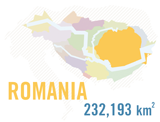Romania - A turning point in Danube water management cooperation

Romania
A turning point in Danube water management cooperation
Twenty years of cooperation under the Danube River Protection Convention have brought significant achievements in integrated river basin management for the Danube countries – as well as for countries around the world.

Credit: ICPDR/Mello

Romania is the largest country within the Danube Basin and the place where the Danube ends its journey to the Black Sea. Before entering the sea, the Danube forms one of the largest wetlands in Europe, with outstanding natural beauty and a valuable wildlife sanctuary.
As a downstream country, water management in Romania has always been influenced by the activities developed in the upper basin of the Danube. So in 1985, Romania signed the Bucharest Declaration establishing the first framework for joint monitoring activities of Danube waters. After the fall of the Iron Curtain in 1989, new opportunities for cooperation emerged and the Danube River Protection Convention was signed on 29 June 1994.
The Convention’s establishment was a
turning point in Danube water management
cooperation. In particular, projects
such as the Monitoring Laboratory and
Information Management, Accident
Emergency Warning System and the
Transnational Monitoring Network clearly
contributed to building and strengthening
the institutional capacity of Danube countries
in order to ensure cooperation. This
is one of the reasons why the ICPDR is a
worldwide model for water management.
Working together on joint challenges. Flood control is a very important concern for Romania, however to tackle this issue – especially considering the effects of climate change – we need a basin-wide approach. This is why the activities developed under the ICPDR framework to implement the EU Flood Directive have been so valuable. These activities were reinforced during Romania’s ICPDR Presidency in 2007 when the Danube Floodrisk Project, one of the main cooperation projects related to flood management, was launched. This project came to successful completion five years later, providing the first atlas of flood hazard and risk maps for the Danube River.
Some of the most exciting activities developed by the ICPDR over the last 20 years of cooperation have been the Joint Danube Surveys. We have had three such experiences and there is much to be proud of – both in terms of the knowledge acquired and ambitious level of the assessments undertaken. We look forward to the next Joint Danube Survey, which we hope will be performed jointly with a Black Sea Survey.
From 2011 there have been new opportunities to promote ICPDR cooperation within the European Union with the EU Strategy for the Danube Region. One of the four pillars defining this strategy focuses on the environment, in particular water protection, water risk management and conservation of the aquatic environment. It is up to us to make the best use of this framework in order to achieve the ICPDR goals.
Looking back on 20 years of cooperation under the Convention, we can say that the political will, commitment, professionalism and determination of the country’s experts and the ICPDR Secretariat have led us where we are today. We still have a lot to do, and issues such as sturgeon migration or floodplain restoration are already in various stages of development. Romania is very proud to be part of this cooperation and is determined to further contribute to the success of Danube River Protection Convention.





